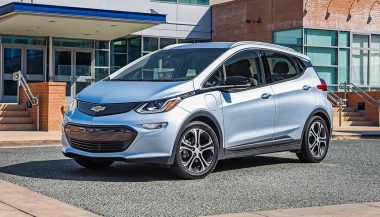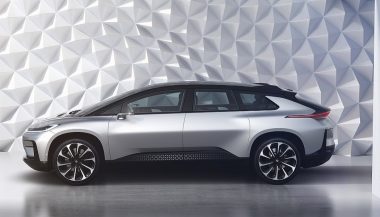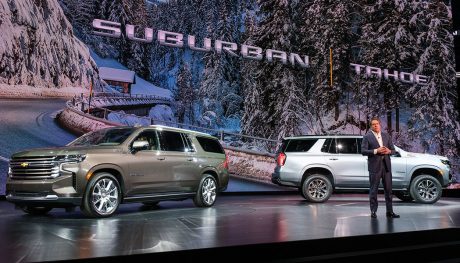
The Workhorse W-15 is a huge rolling power generator.
Workhorse W-15: The First Pickup Truck with Electrified Intentions
It’s been known for quite some time Tesla plans to make a pickup truck. While the media fawns over that fact, another company has gotten down to business and brought an electrified pickup to market, the Workhorse W-15.
While the Workhorse W-15 hasn’t generated quite the fanfare the yet-to-be-named Tesla undoubtedly will, it’s still a monumentally important vehicle. Some consider it more significant than anything Tesla’s done to this point, and that’s certainly debatable.
Considering pickup trucks are incredibly popular in North America, the Workhorse W-15 will help make a big dent in gas consumption. After all, the Model S is pretty much just a plaything for the rich. The W-15, on the other hand, is the working man’s vehicle, a tool used for getting things done.
Not the First Electric Pickup
Some people have tried to discount the importance of the Workhorse W-15 by saying it’s not the first electrified pickup truck. That’s true. Several electrified pickups have come and gone.
It started with the Chevrolet S-10 EV way back in 1997. Most people don’t remember this little experiment GM took on around the same time it made the EV1, the car it famously “killed.” Other trucks retrofitted with electrified powertrains have come since then, like VIA’s extended-range Silverados.
What makes the Workhorse W-15 unique is it was designed from the ground up to be electrified. Plopping a battery in the chassis, plus electric motors, wasn’t an afterthought. It’s an important step that’s taken a surprisingly long time to happen.
How It Works
I’ve been careful to not call the W-15 an electric pickup. Technically, it is, but it’s not a purely electric vehicle. Instead, it’s electrified like the Chevy Volt. It moves via two electric motors – one in front, and one in the rear. A Panasonic 18650 lithium-ion battery supplies electricity.
Where you’d expect the engine on other pickups is an internal combustion range-extending engine. It runs on gasoline. That’s good, because the electric-only range is a mere 80 miles. That might be enough for some work days, but other times company trucks need to go further. The gasoline engine works like a generator, supplying electricity when the battery is depleted.
If it has a full tank of gas, the truck can go 310 miles. When it’s running on just electricity, it gets 75 MPGe, or 28 mpg highway and 32 city when using the range-extender engine.
When the truck is parked, you can plug it in to recharge the battery. The electricity doesn’t just flow in. You can plug-in power tools, lights, or whatever you need on a remote site. Basically, the W-15 works like a giant, rolling power generator.
Speaking of utility, Workhorse says the W-15 can tow up to 5,000 pounds. It can also haul up to 2,200 pounds in the payload.
You also get all-wheel drive, thanks to the two motors powering all four wheels. Lane departure warning and automatic braking come standard. The W-15 puts out 460 horsepower, so it’s not a weakling. It’s also pretty quick, going 0-60 in 5.5 seconds.
Drivers control pretty much everything through the two touchscreens. You control the transmission through a knob in the center stack. Workhorse says the controls are all ergonomical.
Commercial First
Nobody knows how the future Tesla pickup truck will work. It could be like the Model S – something only rich guys drive to look or feel cool. One thing’s for sure, the W-15 is made first and foremost as a work truck. In fact, it’s being marketed to fleet managers as the ultimate commercial utility vehicle.
The strategy seems to be working. Workhorse says it’s received thousands of letters of intent from all kinds of organizations. They’re eager to reap the benefits of the electrified pickup.
One of the most attractive things about the W-15 is the low total cost of ownership. Part of that is because it consumes so little gas. That’s the kind of thing fleet managers stress over, so they’re pumped about the possibility spending less at the pump.
This doesn’t mean average consumers are screwed. If you go to the Workhorse W-15 page, there’s a banner where you can click on a button to express your interest as a consumer in getting one. Workhorse won’t say how soon it would open orders to consumers, if it even decides to. That means for now, it’s a commercial-only light truck.
Coming Late 2018
MSRP for the Workhorse W-15 is $52,500. That’s not cheap, but it’s also not horribly expensive. Thanks to the low total cost of ownership, companies and organizations are lining up to get their hands on one. It’s understandable why the average Joes also want one, especially if you look at the cost of full-size pickups these days.
The bad news is production of the W-15 will fire up in late 2018. That means most people won’t have one until 2019. Ryder will be the primary distributor, so you can go to any of about 800 locations throughout the United States for sales and service support, something that’s been a problem for Tesla.





